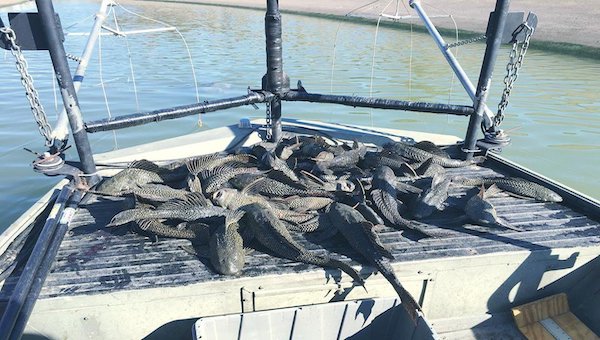 Fisheries biologists caught invasive armored catfish in Houston bayous in 2017.
TPWD Fishing via Twitter
Fisheries biologists caught invasive armored catfish in Houston bayous in 2017.
TPWD Fishing via Twitter
MORE THAN 400 INVASIVE FISH DUMPED FROM AQUARIUMS FOUND IN TEXAS RIVER
BY: MARGARET OSBORNESITE: SMITHSONIAN
TRENDING
Activism
Belief
Big Pharma
Conspiracy
Cult
Culture
Economy
Education
Entertainment
Environment
Global
Government
Health
Hi Tech
Politics
Prophecy
Science
Social Climate
Universe
War
Researchers from Texas A&M and Texas State universities pulled 406 invasive suckermouth armored catfish from the San Marcos River in Texas earlier this month, per a Texas Parks and Wildlife Facebook post.
The catfish, also called plecostomus or plecos, are native to South America, Panama and Costa Rica, but were introduced into numerous water bodies in Texas after people dumped them from aquariums. The fish are popular among aquarists because they eat algae in tanks.
“A lot of time people purchase plecos for their fish aquariums to clean the bottoms of the fish tanks and the sides and keep algae out of the fish tanks, and they don’t realize they can get up to two to two-and-a-half feet long,” Melissa Bryant from the San Antonio River Authority tells KENS5’s Sue Calberg.
Plecos grow rapidly and can survive out of water for more than 20 hours. The fish has armored skin and no natural predators in Texas. All of these factors combined made their population explode, causing problems for Texas rivers.
“They take over important habitats such as springs, push out and replace native species (including listed species and species of conservation concern), decimate native vegetation and undermine and destabilize banks.” Gary Garrett, a fisheries scientist and Texas Parks and Wildlife Department’s Director of Watershed Conservation, said in a 2011 statement. “In no way do they have any redeeming qualities.”
The cost of invasive species in North America has increased in the past 50 years. In the 1960s, invasives cost an average of $2 billion per year. In the 2010s, that number spiked to over $26 billion. Invasives also harm native wildlife; per the National Wildlife Federation, “approximately 42 percent of threatened or endangered species are at risk due to invasive species.”
Scientists suspect the armored catfish may have caused population reductions in a native species called Devils River minnows that live in San Felipe Creek in Texas, per a Texas Parks and Wildlife post.
.@Cody_is_Cray Armored Catfish dig burrows like these which destabilize banks, increase erosion, and increase water turbidity. They also out-compete and overwhelm native species of fish. pic.twitter.com/Ql0hEUggnF
— TPWD Fishing (@TPWDfish) December 7, 2017
The 400 fish collected from the San Marcos River will be euthanized using a fish anesthetic and used for research, specifically population control methods, says Monica McGarrity, Texas Parks and Wildlife Department's senior scientist for aquatic invasive species, to Newsweek’s Catherine Ferris.
"They want to look at the age and growth rate of the individuals in the river to get information about population dynamics," McGarrity tells Newsweek.
Researchers fitted suckermouth armored catfish in the San Marcos River with tags last year to study their movements and increase the effectiveness of removal efforts. The fish are not prohibited in Texas and current management focuses on increasing awareness about not releasing aquarium life, per a Texas Parks and Wildlife Facebook comment.
Click 3 Dots Below to View Complete Sidebar


